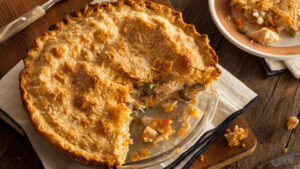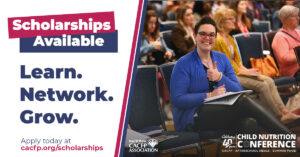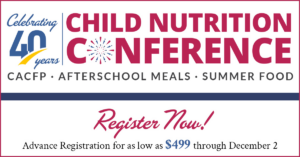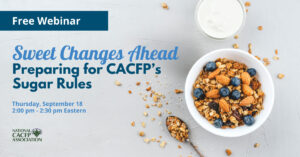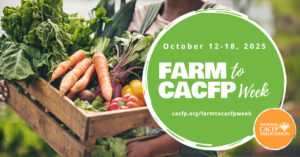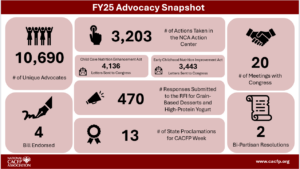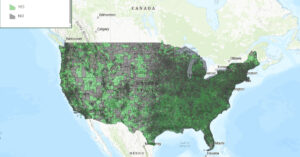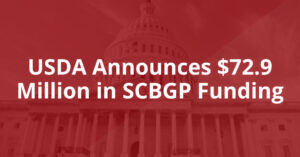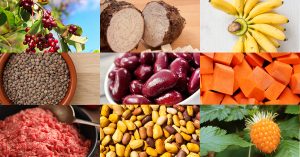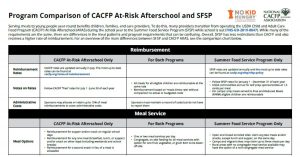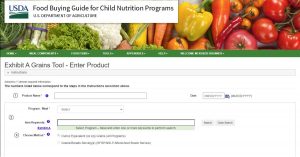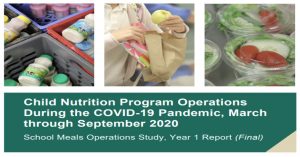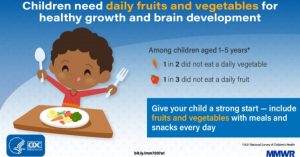Can all ingredients in a smoothie be credited in the CACFP?
Read MoreThe Stanford Center on Early Childhood released a RAPID report that looks at how issues of food insecurity and hunger are affecting adults who provide care for young children. Their key finding: hunger is on the rise among child care providers.
Read MoreCan a parent or guardian supply a meal component for their infant in the infant meal pattern?
Read MoreCould the crust of a chicken pot pie credit as the grains component?
Read MoreThe National CACFP Association (NCA) is proud to continue its annual scholarship program for the 2026 National Child Nutrition Conference (NCNC), taking place April 13–17, 2026, in Las Vegas, Nevada.
Read MoreWe are closely monitoring the potential government shutdown on October 1 and its impact on the CACFP. As your trusted partner, we’ll keep you informed with timely updates.
Read MoreOver 2,000 key stakeholders and professionals from the Child and Adult Care Food Program (CACFP) and Summer Food Service Program community will convene for a week of nutrition education and professional development at the 40th annual National Child Nutrition Conference (NCNC) in Las Vegas, Nevada, from April 13–17, 2026.
Read MoreRegistration for NCNC26 is now open! Get ready for our 40th Anniversary – five days of training, networking and fun.
Read MoreBeginning October 1, 2025, the Child and Adult Care Food Program (CACFP) will implement new regulations requiring limits on added sugars in breakfast cereals and yogurts served in child and adult care settings.
Read MoreThis October marks the inaugural Farm to CACFP Week, hosted by the National CACFP Association to celebrate the benefits of connecting child and adult care programs with local foods.
Read MoreThe government shutdown has continued into November as Congress has yet to reach an agreement on Fiscal Year 2026 funding. We’ve put together a list of resources and ideas for providers to help families that experience disruption to food programs during the shutdown.
Read MoreWe are closely monitoring the potential government shutdown on October 1 and its impact on the CACFP. As your trusted partner, we’ll keep you informed with timely updates.
Read MoreCACFP advocacy is central to the mission of National CACFP Association (NCA) and NCA is continuously working to support and advocate for you! This year, we’ve worked to help raise awareness, expand and improve the CACFP. Your NCA membership supports these efforts. THANK YOU!
Read MoreIn the last few months, there have been many actions by USDA, HHS, and Congress impacting Child Nutrition Programs. Keep reading to see what you’ve missed and stay up to date with CACFP policy!
Read MoreSeptember 29, 2025 USDA announced that the CACFP and SFSP Area Eligibility Mapper has been updated for fiscal year 2026. Why It Matters Census data and school data are the two primary sources that may be used to determine whether a site is area eligible in CACFP and SFSP. Area eligibility is used to determine…
Read MoreUSDA announced $72.9 million in grant funding to states through the Specialty Crop Block Grant Program. The purpose of the SCBGP is to enhance the competitiveness of specialty crops, including fruits, vegetables, tree nuts, dried fruits, horticulture and nursery crops (including floriculture).
Read MoreExciting news! Head Start programs have an opportunity to access one-time supplemental funds to support nutrition services and healthy eating for enrolled children and families. You can use this funding for staff training on resources and educational opportunities to help your program improve outcomes for children and families and align with USDA requirements – like the CACFP!
Read MoreThe Child and Adult Care Food Program has new creditable foods listed on the USDA Food Buying Guide! If you are new to the FBG, this interactive tool allows for easy display, search, and navigation of food yield information. In addition, users can compare yield information, create a favorite foods list, and access tools, such as the Recipe Analysis Workbook (RAW) and the Product Formulation Statement Workbook.
Read MoreThe Child and Adult Care Food Program community asked for more Spanish resources to be available on the National CACFP Sponsors Association website and we heard you! Available now in Spanish are more resources to help sponsors and providers with meal pattern requirements, best practices, and so much more!
Read MoreServing meals to young people year-round benefits children, families, and care providers. To do this, many providers transition from operating the USDA Child and Adult Care Food Program (CACFP) At-Risk Afterschool (ARAS) during the school year to the Summer Food Service Program (SFSP) while school is out. For an overview of the main differences between SFSP and CACFP ARAS, see the comparison chart below.
Read MoreNCA understands that the end of flexibilities will cause challenges for many CACFP sponsors and providers and we commend your continued commitment to providing nutritious meals and snacks to the children or adults in your care. In preparation for the end of the additional reimbursement, we have collected the following resources to help you successfully provide meals even if your available budget decreases.
Read MoreCan all ingredients in a smoothie be credited in the CACFP?
Read MoreCan a parent or guardian supply a meal component for their infant in the infant meal pattern?
Read MoreCould the crust of a chicken pot pie credit as the grains component?
Read MoreAre juice cocktails creditable in the CACFP?
Read MoreIs raw cow’s milk creditable in the CACFP?
Read MoreDoes mixing fresh fruits into yogurt count towards added sugars?
Read MoreExciting news! Head Start programs have an opportunity to access one-time supplemental funds to support nutrition services and healthy eating for enrolled children and families. You can use this funding for staff training on resources and educational opportunities to help your program improve outcomes for children and families and align with USDA requirements – like the CACFP!
Read MoreThe Child and Adult Care Food Program has new creditable foods listed on the USDA Food Buying Guide! If you are new to the FBG, this interactive tool allows for easy display, search, and navigation of food yield information. In addition, users can compare yield information, create a favorite foods list, and access tools, such as the Recipe Analysis Workbook (RAW) and the Product Formulation Statement Workbook.
Read MoreThe Child and Adult Care Food Program community asked for more Spanish resources to be available on the National CACFP Sponsors Association website and we heard you! Available now in Spanish are more resources to help sponsors and providers with meal pattern requirements, best practices, and so much more!
Read MoreServing meals to young people year-round benefits children, families, and care providers. To do this, many providers transition from operating the USDA Child and Adult Care Food Program (CACFP) At-Risk Afterschool (ARAS) during the school year to the Summer Food Service Program (SFSP) while school is out. For an overview of the main differences between SFSP and CACFP ARAS, see the comparison chart below.
Read MoreNCA understands that the end of flexibilities will cause challenges for many CACFP sponsors and providers and we commend your continued commitment to providing nutritious meals and snacks to the children or adults in your care. In preparation for the end of the additional reimbursement, we have collected the following resources to help you successfully provide meals even if your available budget decreases.
Read MoreParticipate by July 14 in a nationwide survey of CACFP Sponsors and Providers being conducted by the Harvard T.H. Chan School of Public Health.
Read MoreIn May 2023, the USDA’s Food and Nutrition Service (FNS) published a report focused on Child Nutrition Program (CNP) operations during the first few months of the COVID-19 pandemic, March through September 2020, including information on the nationwide waivers that FNS approved for use during that period.
Read MoreIn February 2023, the CDC released state-level data on fruit, vegetable, and sugar sweetened beverage (SSB) intake among young children. The data was collected through a 2021 national survey in which respondents were asked three questions about children aged 1–5 years regarding the frequency of consuming fruits, vegetables, and sugar-sweetened beverages during the preceding week. The report found that many young children between ages 1 and 5 years old are not eating fruits and vegetables each day and are regularly drinking SSBs.
Read MoreIn December 2022, the Indiana University CACFP Project Team released a report describing the child nutrition and care provision experiences among early care and education (ECE) stakeholders, sponsors, and center directors during the COVID-19 pandemic. The study was conducted in four states and a variety of ECE stakeholders participated. The study identifies six common experiences among ECE stakeholders during the COVID-19 pandemic.
Read MoreIn December 2022, the Indiana University CACFP Project Team released a report describing the facilitators and barriers to CACFP participation by family child care homes (FCCHs). The report concludes with suggestions for potential strategies to promote participation in the CACFP by FCCHs. The study was conducted in two states, Arizona and New York, that have varying levels of CACFP participation. The study outlines the facilitators and barriers to FCCHs’ enrollment in CACFP and recommends a few strategies to increase participation.
Read More





